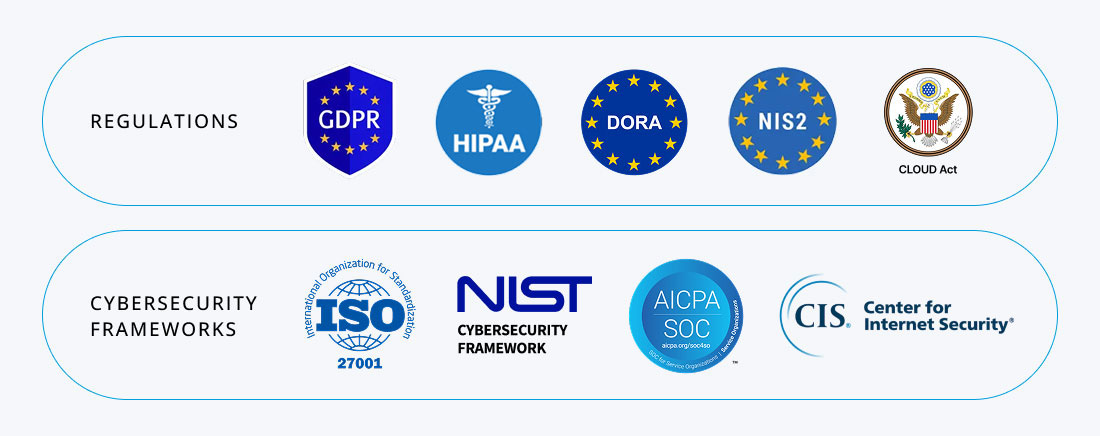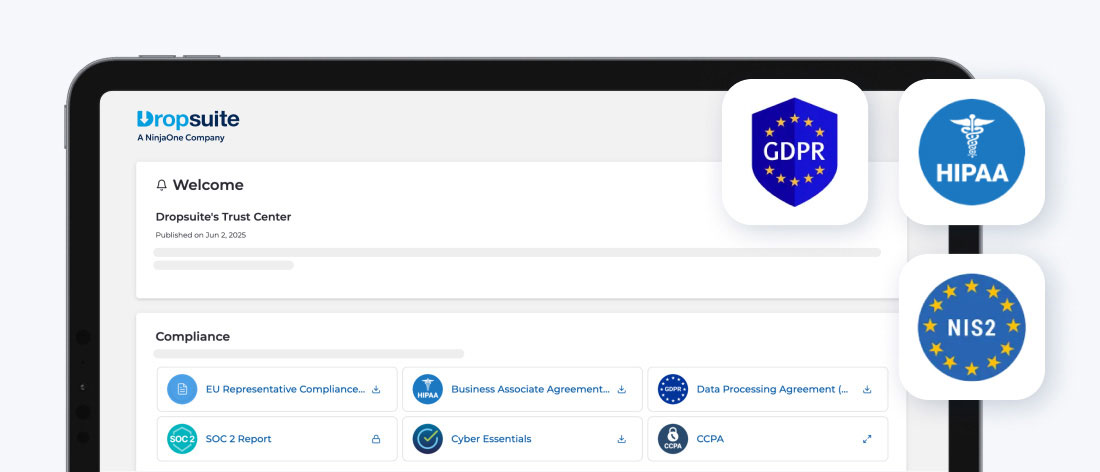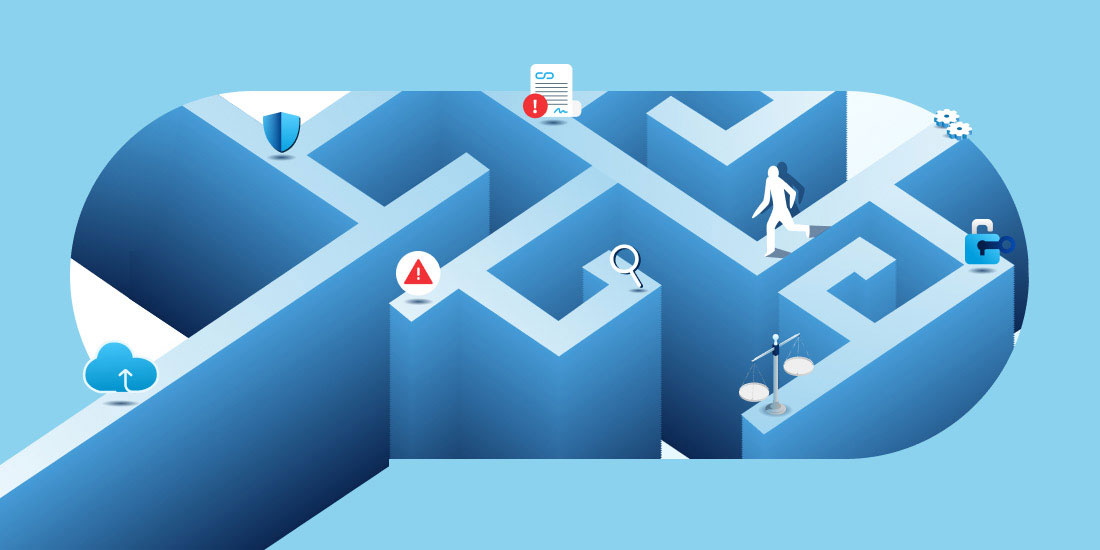Estimated Reading Time: 5 Minutes
As an MSP, your clients look to you for IT solutions that keep their businesses secure and compliant.
However, with the increasing complexity of global regulations (like GDPR compliance, HIPAA compliance, DORA, and NIS2) and cybersecurity frameworks (like ISO 27001, SOC 2, and NIST Cybersecurity Framework), understanding your role in client compliance is critical.
Equally important is addressing the question of liability: Are MSPs responsible for ensuring that their clients remain compliant?
This blog explores the intersection of regulatory compliance, frameworks, and MSP accountability, offering practical steps to meet compliance needs while clearly defining your role in the compliance equation.
1. Regulations vs. Cybersecurity Frameworks: Know the Difference
Compliance definition: Compliance refers to adhering to laws, regulations, and standards that govern specific industries or practices.
To navigate compliance successfully, it’s essential to differentiate between regulations and frameworks:
- Regulations: These are legal mandates enforced by governments or industry authorities. Non-compliance can lead to significant fines, legal action, and reputational damage.
Examples: GDPR, HIPAA, DORA, NIS2, CLOUD Act.
- Cybersecurity Frameworks: These are voluntary guidelines and best practices designed to help organizations achieve compliance and strengthen security.
Examples: ISO 27001, NIST Cybersecurity Framework, SOC 2, CIS Controls.

While regulations define the “what” (what organizations must achieve to comply with the law), frameworks provide the “how” (how to implement security and operational controls to meet compliance).
2. Regulations Managed Service Providers Must Understand
Here are some key regulations that directly or indirectly impact MSPs:
1. GDPR (General Data Protection Regulation)
- Scope: Protects the personal data of EU residents, regardless of where businesses operate.
- MSP Focus: Secure data storage, encryption, deletion upon request, and breach notification. MSPs must ensure their solutions enable clients to comply with GDPR compliance regulations.
2. HIPAA (Health Insurance Portability and Accountability Act)
- Scope: Regulates Protected Health Information (PHI) in the U.S. healthcare industry.
- MSP Focus: Implement robust encryption, access controls, and secure backups. MSPs accessing PHI must sign Business Associate Agreements (BAAs) to ensure HIPAA compliance.
3. NIS2 (Network and Information Systems Directive)
- Scope: Strengthens cybersecurity for critical infrastructure and services in the EU.
- MSP Focus: Mandates secure backups, rapid recovery, and strict incident reporting to reduce cyber risks.
4. DORA (Digital Operational Resilience Act)
- Scope: Applies to EU financial entities and their third-party ICT providers (including MSPs), effective January 2025.
- MSP Focus: Requires ICT risk management, incident response plans, and operational resilience testing.
3. Cybersecurity Frameworks to Guide MSP Compliance
Frameworks provide a roadmap for MSPs to help clients achieve regulatory compliance while improving overall security posture:
- ISO 27001: A global standard for risk-based information security management.
- SOC 2: Focuses on safeguarding client data under five Trust Principles: security, availability, processing integrity, confidentiality, and privacy. Dropsuite is SOC 2 Type 2 certified.
- NIST CSF: Offers guidelines for implementing security controls, aligning well with regulations like HIPAA and NIS2.
- CIS Controls: A prioritized list of security actions ideal for SMB clients.
Leveraging these frameworks enables MSPs to align with governance risk and compliance requirements while offering scalable solutions to clients across industries.
4. Are MSPs Liable for Client Compliance?
The short answer: Clients remain ultimately accountable for their compliance obligations, but MSPs share responsibility for implementing the tools, processes, and controls that support compliance. It’s also worth noting that blame for failures is increasingly shifting towards the MSP and IT communities.
A recent joint cybersecurity advisory (CISA, NSA, FBI, and international agencies) emphasizes the need for a shared responsibility model between MSPs and their customers. The advisory provides specific recommendations for MSPs to reduce risk and define roles clearly:
Shared Commitments
- Prevent Initial Compromise: Implement measures to protect against phishing, brute force attacks, and vulnerabilities in internet-facing services.
- Monitor and Log: Maintain detailed logs for at least six months and enable endpoint detection and network defense.
- Secure Remote Access: Enforce multifactor authentication (MFA) and harden remote access infrastructure.
- Incident Response Plans: Develop and test incident response plans, defining roles for MSPs and clients in case of cyber events.
- Supply Chain Risk Management: Collaborate with clients to assess and mitigate risks across vendors and third parties.
Why It Matters: Clients are legally accountable for compliance but must ensure MSPs meet baseline security and regulatory measures through clear contractual agreements. Failure by MSPs to fulfill their responsibilities can expose both parties to cyber risks, operational disruptions, and reputational damage. Depending on their role, service scope, and contractual obligations, MSPs may also carry indirect liability or share responsibility for compliance outcomes.
5. How MSPs Can Reduce Risk and Add Value
To clarify roles and build trust with clients, follow these best practices:
1. Implement Shared Responsibility Matrices
Use Shared Responsibility Matrices (SRMs) to define who is accountable for specific tasks, from encryption and access controls to incident reporting. This eliminates ambiguity and sets clear expectations.
2. Adopt Compliant Backup and Archiving Solutions
Leverage tools that align with regulations and frameworks: Dropsuite ensures GDPR, HIPAA, and NIS2 compliance with features like AES 256 encryption, automated backups, granular recovery, and audit trails. To learn more about how Dropsuite helps meet specific regulatory requirements, explore our whitepaper.

3. Update Client Contracts
Review managed services agreements (MSAs) to include language specifying responsibilities, SLAs, and additional fee-based services for incident response and remediation.
4. Continuously Test and Improve
Conduct regular resilience testing and compliance audits to ensure readiness for evolving regulations like DORA and NIS2.
5. Educate Clients
Proactively educate clients on their role in compliance, the importance of collaboration, and the shared responsibility for protecting networks and data.
6. Turn Compliance into Opportunity
By embracing compliance and risk management as part of your managed services offering, you can:
- Strengthen Client Trust: Clients will view your MSP as a strategic partner who reduces risk and enables compliance success.
- Grow Your Service Portfolio: Add compliance management, secure backup, and incident response as value-added services.
- Reduce Liability: Clearly defining roles and responsibilities minimizes misunderstandings and legal exposure.
Dropsuite’s cloud-based solutions empower you to simplify MSP compliance for clients while meeting global standards for data security, privacy, and resilience.
Next Steps for MSPs
Ready to simplify compliance for your clients? Learn more about Dropsuite’s secure backup and archiving solutions: Explore Dropsuite Compliance Solutions. Additionally, we offer MSPs access to a free trial of NFR (Not for Resale) licenses to test Dropsuite within your own organization.






